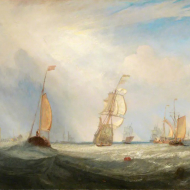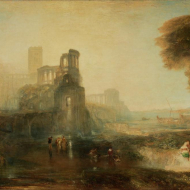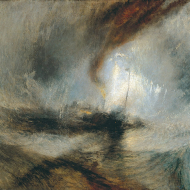Same period (19th century), different techniques and approach to painting, admiration but also criticism. J.M.W. Turner and John Constable.
During the Romantic period, portraits or themes depicting historical events were especially valued in painting. The British painters J.M.W. Turner (1775-1851) and John Constable (1776-1837) were among the artistic elite despite the fact that they were mainly devoted to landscapes, Turner mainly to seascapes. Although they were only a year apart in age, their work and overall philosophy of life were so different that it gradually led to one of the most famous rivalries.
Constable was born into a well-off family, his father was a corn merchant, so it was natural that his son would also be a businessman. Well-dressed and handsome, he was the opposite of his later rival Turner, who, on the contrary, came from poorer circumstances and generally did not have a very good reputation. Perhaps thanks to his good background, Constable was not in such a hurry to study art. He did not enter the Royal Academy of Arts until he was 22 years old and studied for 11 years. Despite his difficult childhood, Turner's great talent was evident from an early age. He enrolled at the Academy at the age of 14 and a year later his work was accepted for the Academy's Summer Exhibition. Later, he worked there as a professor for more than 20 years.
Constable's goal was to depict the landscape as realistically as possible. He preferred tranquility and approached his work with a classical and then recognized approach, thanks to which he established himself as one of the most important representatives of English landscape painting. He preferred to depict peaceful landscapes, rural scenes. Turner, on the other hand, traveled a lot and wanted to capture in his works the impression, the feeling, which he achieved in his work through experiments and a new modern approach to painting. His technique was characterized by dynamism, quick strokes, and swinging. Turner was fascinated by light and is sometimes considered a predecessor of Impressionism.
Although they did not meet much in person, the tension between these two different artistic and personal worlds was palpable. Turner did not even consider it necessary to comment on Constable's work, which he considered too static and unable to capture the dynamics of the landscape. Although Constable publicly praised Turner's work, words of criticism were mainly heard among his friends. He considered his abstract approach to be simplified, and some works were even described as "blurred". He clearly preferred art to reflect a true image of the world. As a married man, he certainly did not like Turner's promiscuous life. Turner never married, had several mistresses, probably children. Constable had 7 children and was with his wife until she died of tuberculosis. Turner was more associated with the London art salons and was popular with the aristocracy and intellectuals, while Constable had difficulty gaining recognition in London and was considered more of a "country" painter who gained more recognition in England than in a wider European context...



.jpg)